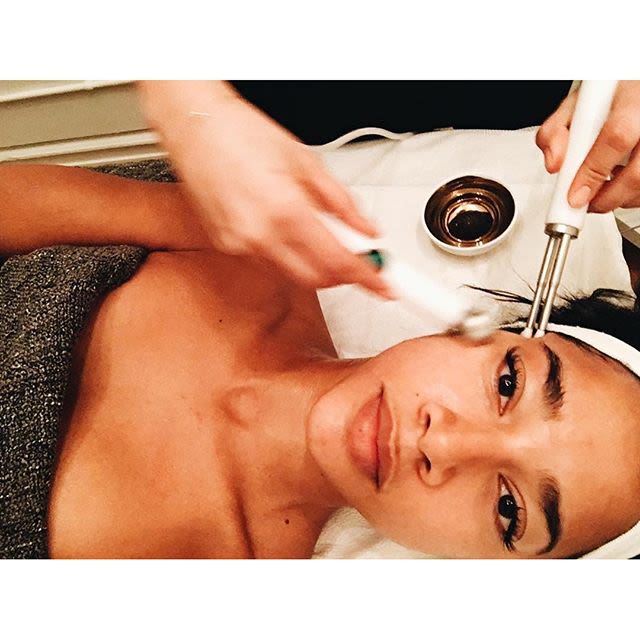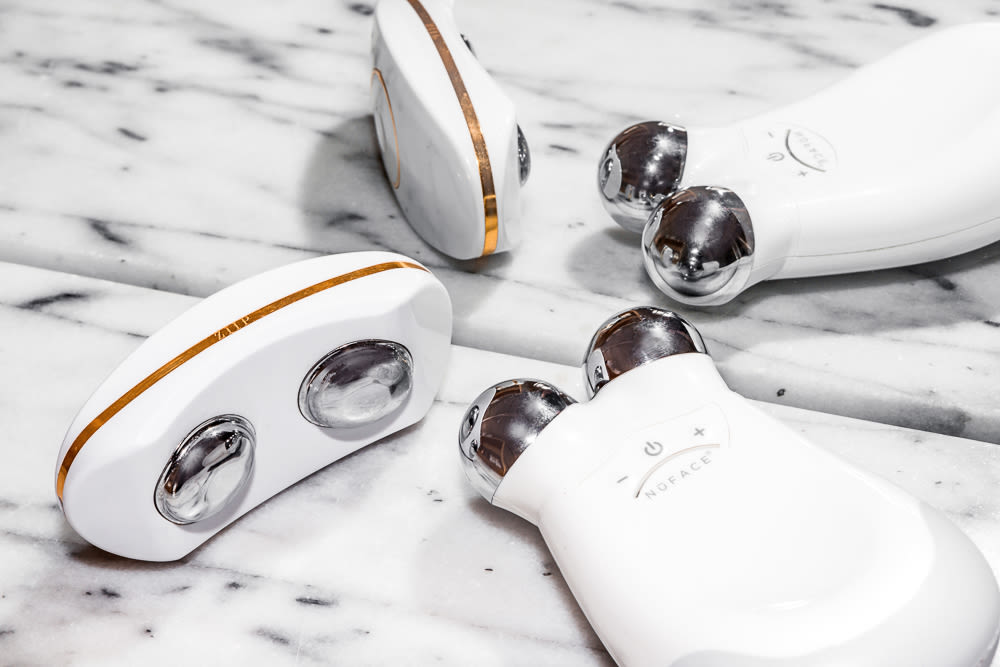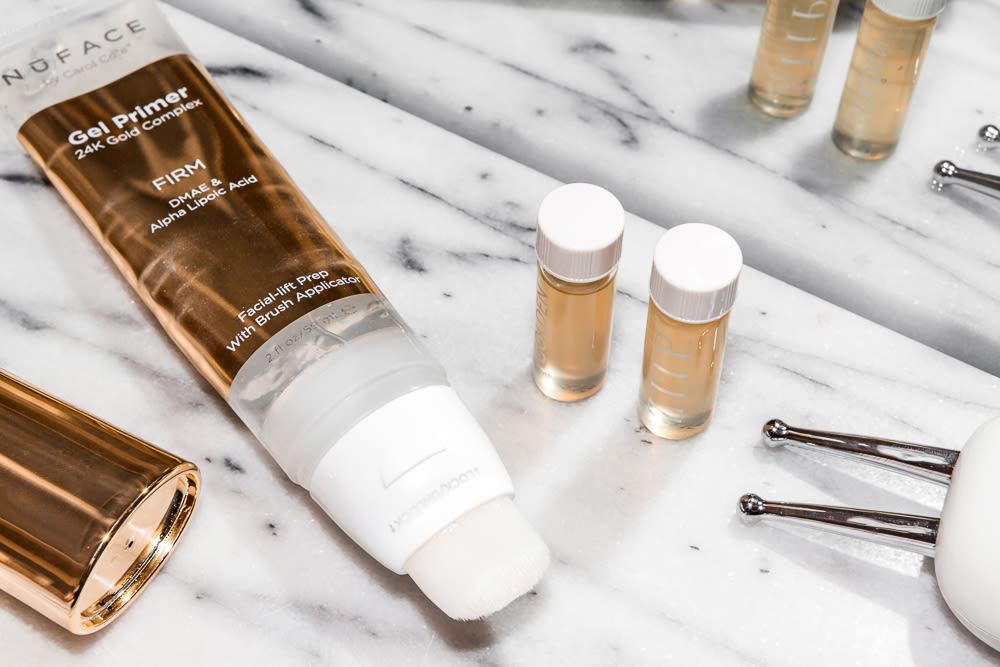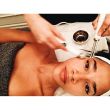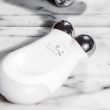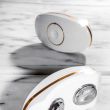“It’s not about skin,” said Shamara Bondaroff, aesthetician and founder of SBSkin, as she held an electrical current wand the size of a cattle prod up to my face. “It’s about muscle.”
What followed was a gentler experience than you might imagine. It was my first microcurrent facial, and I wasn’t as prepared as I thought. I say this despite the noticeably escalating buzz around microcurrent in the beauty world for the past year or so. (A person less restrained than myself might call it “The Microcurrence.”) For one, it couldn’t be endorsed by a higher register than the already upper-A-listers: Cult facialist Joanna Vargas is overrun at her practice, with the likes of Julianne Moore and Madonna singing her praises. And Ildi Pekar too, who’s frequented by Miranda Kerr. Microcurrent is rumored to be the trick behind Jennifer Aniston’s years-long Benjamin Buttoning performance art. (Whatever she’s doing, “aging” she’s not.)
Then there’s the at-home tech: most notably the Bobbi Brown favorite Nuface. It’s joined by the Ziip (thanks for the tip, Kristie Streicher) and Lancer Skincare’s very fancy gold wand (now out of stock at Nordstrom). But it all started with these two ruler-long rods of current, that look like either a giant’s shrimp fork or some squished tuning rods. And I was getting them swirled over my always-ready-to-be-improved face.
It’s a simple tool, really. Two wands, negative and positive, and electrical current running between—exponentially less than could even power a light bulb. Put both wands on your face, and electrical current flows through the skin and facial muscle, causing not so much a contraction as a tightening. It doesn’t feel like anything's happening. Although, and I’m not new-agey, I did feel a heightened sense of energy. I felt almost, as the kids say, hype.
This may be attributed to Bondaroff, an open talker, microcurrent zealot, and (it’s alleged by several clients), a true healer. “You feel alive,” she says of microcurrent’s effect. “There’s a brightness. The energy flow in your face—it’s better than caffeine. You look rested.” Her holistic approach takes some of the weight off the loom of the future, too. “There’s no such thing as anti-aging—you can’t stop it, so let’s just do it as gracefully as possible.”
Before we get too far into it, it’s important to note that this stuff isn’t really new. The tech was born around the turn of the century as a strictly medical device, targeting atrophy in patients with Bell’s palsy and muscle paralysis. The prods were used all over the body, including the face (a type of this physical therapy is still practiced today). After patients’ faces seemed to benefit in unexpectedly glowing ways, microcurrent was picked up by the esthetic crowd too. Now it’s advertised as a treatment to lift, tone, and firm the skin without the knives of a facelift.
Off-label, Bondaroff says she’s seen everything from rosacea to acne clear up over the course of a few treatments. (One of the worst cases of rosacea cases she cleared up was her own.) With all the promise of lift, it’s easy to peg microcurrent as an anti-aging treatment (which, in the beauty world, means it can be started in one’s late twenties), but theoretically any prom-goer or senior-picture-taker could benefit from its boost.
But, post-facial, my own results were sort of startling. There seemed to be more of my face in this bizarre new way. I realized, after a second, that this was because my hairline was higher. Like Mona-Lisa-high. I didn’t even know I had a nasolabial depression until I didn’t have one anymore. I looked really surprised, but I wasn’t moving any surprise-face muscles. Reader, it was weird.
According to Bondaroff’s clients, the benefits are on par with more drastic measures. “I’ve weaned people off Botox, off fillers,” she says. The paradox of Botox, says Bondaroff, is that it can actually cause atrophy, since it paralyzes facial muscles. So microcurrent “is essential if you do Botox,” re-stimulating the frozen muscle to keep a paralyzed forehead lifted and high, not just slack. If this seems on the vicious end on the cycle spectrum, I feel the same. “It’s such a gimmick, and they’re getting girls to do it younger and younger,” she says of Botox. “I have girls come to me who have been doing it for years, and they say, ‘Can you help me? My eyebrows are dropping.” Eventually, “what happens is, they look better with microcurrent than Botox, so the girl who was getting it every three months is now maybe every six to nine months.”
Joanna Vargas, whose embrace of microcurrent helped propel its popularity, believes her treatments can offer a defter, subtler lift that ages better than an actual facelift. “The point of microcurrent isn't to erase lines in the same way fillers and Botox do. Microcurrent is awesome for lifting the muscle and de-puffing the face,” she explains, along with fluid-draining and contour-enhancing side effects. She recommends starting microcurrent in one’s late 20s, with monthly maintenance facials, and speaks reverently about its “cumulative effect”. Besides, according to her, the Nip/Tuck trend is on its way out. “I think people see that, ultimately, surgery is flawed,” she says. “No one wants to be a cautionary tale."
One more thing. These facials are expensive. Prohibitively. The pros don’t come cheap. Or, you can turn to less potent, but more available, measures. The at-home devices that have been cleared for home use are themselves pretty expensive, but only cost as much one or two professional facials (and offer a theoretically infinite number of sessions). Unfortunately, the wattage is just not the same.
“The Nuface? That’s like 5% of what I can do with this,” I remember Bondaroll saying, brandishing those calipers. “But it’s good. It gives you a little lift, but not a full lift.” I’d received the NuFace not long before my first SBSkin-tervention. I’d tried it. Nothing much happened, but nothing’s really supposed to after a single session. It’s true that it can’t instantly replicate the results of a professional microcurrent facial (believe me, I hoped that it could). So while it’s a less potent force, it’s still a worthwhile one.
The Nuface is a single handheld unit with two metal nodes. It also requires a generous slather of conductive gel, very ultrasound-y. If you put the live device against bare skin, you will feel little shocks. Besides being unpleasant, this is also counterproductive—that electricity’s pricking skin’s surface instead of going deep into the muscle. The gel helps with electrical penetration and makes the shocks un-feel-able. The actual administration is sort of soothing, the repetitive up-and-out. And at the end of the treatment, my skin feels the tiniest bit firmer to the touch, with no layover redness. The pamphlet copy tempers expectations right away, asking for six weeks of use before you really see what the device can do. I love doing it at night, but so far the results I’ve seen have been strictly immediate—in the morning I’m back to normal.
For those who want their facial electricity delivered by a device that looks like Apple collaborated with Star Trek, there’s the Ziip. Developed by esthetician Melanie Simon as an echo of her own nanocurrent facial, it’s at the higher-end of at-home electric tech. It’s gorgeous—clinically white and ribboned with gold. “Nano-current” electricity has a lower frequency than microcurrent (no iota-current is available yet).
And it’s high-tech on the interface-front, too, with an app that programs different rounds of treatments. Instead of fiddling with buttons directly on the device itself, you select the program you want on your phone (currently three available), and it Bluetooths it over to the Ziip. There are special programs for sensitive skin (an even lower frequency) and acne (with bacteria-zapping pulses). It’s an elegant machine.
The pro: you don’t need to do it every day. The con: you don’t get to do it every day. Also, the temptation to preserve the super-expensive gold-laced conductive gel will be overpowering. But a paper-thin layer will make the device prickly, just like the NuFace sans gel. You’ll feel it. A thick, sticky layer will let the ZIIP slide around like it’s meant to, and it’s recommended to leave the gel on after, like a serum. I don’t know if it’s the combination of current and gel, but I have noticed a more hydrated fullness and pertness the next day. More drainage, shallower forehead grooves. This guy works overtime.
Despite all the effusive anecdotal response, some dermatologists are unconvinced by microcurrent’s hype, whether in the esthetician’s or the civilian’s hands. I emailed briefly with Dr. Elizabeth Tanzi, who is the founder & director of Capital Laser and Skin Care in Maryland, and well as being an Assistant Clinical Professor in the Department of Dermatology at George Washington University Medical Center. She’s not convinced.
“There is no scientific evidence yet that these treatments are helpful,” she said. “It remains to be seen. We need to see the actual clinical studies rather than one or two facialists saying, ‘It works.’ That’s not very scientific or reliable.” She also dismissed the idea that facial muscles could be “trained.” When I asked about home devices, she said she wouldn’t recommend them to a patient, but wouldn’t outright advise against them. “I don’t think there would be any harm in them unless the device was defective, but it may just be a waste of time.”
Of course, “the jury’s still out” game can be played with a lot of skincare trends. A lot of the skincare-trend-casting game is all about bet-hedging, just-in-casing, and generally not-waiting for the warm embrace of the medical community. For now, microcurrent seems to be in that middle ground between “just marketing” and “doctor tested and approved.” That middle ground is a place inhabited by Jennifer Aniston, Emma Stone, and their perfect faces. From that, you’re free to draw your own conclusions.
—Trace Barnhill
Photos via Hannah Bronfman's Instagram [1] and photographed by Tom Newton [2-4].
More at-home treatments: Have you tried dermarolling?
